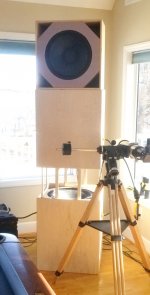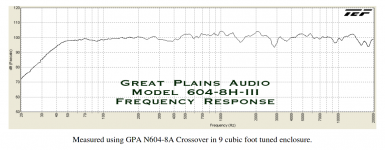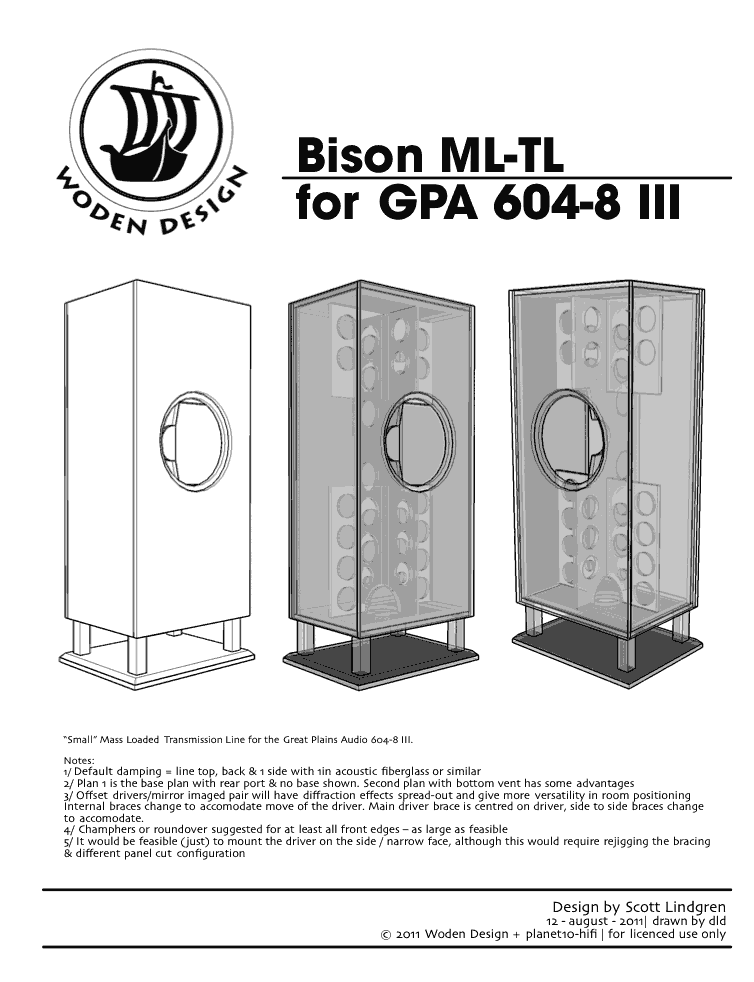Hi,
why can’t I seem to be able find any info or plans or even many photographs of boxes running single big (12”, 15” and beyond) coaxial drivers?
There was a thread a few months back listing several very nice 12” coaxial drivers but what do people use these for?
Also when calculating for a new box how should I go about it? Use only the woofer side of the data sheet for input info?
why can’t I seem to be able find any info or plans or even many photographs of boxes running single big (12”, 15” and beyond) coaxial drivers?
There was a thread a few months back listing several very nice 12” coaxial drivers but what do people use these for?
Also when calculating for a new box how should I go about it? Use only the woofer side of the data sheet for input info?
Learn HornResp, its pretty awesome.
You can download spec files from loudspeaker data base to import right into it...WinISD is probably a little more beginner friendly.
You can download spec files from loudspeaker data base to import right into it...WinISD is probably a little more beginner friendly.
I'm playing with WinISD right now.camplo said:WinISD is probably a little more beginner friendly.
But let's say I'm calculating for Sica 12 Cx 3 CP. Do I input Fs 49Hz or 1100Hz?
planet10 said:Coincidently just started a design for the Eminence Beta 10CX
"50Hz to 4KHz" Is that even coaxial?
I've been looking at the Sica 12 Cx 3 CP (50Hz to 20KHz) or the FaitalPRO 12HX500 (50Hz to 20KHz)or something else from the "Cheap and decent 12” coax" thread.
The Beta 10 is a driver purchased separate from the tweeter and they are giving you just the woofer specs.
There is a new Celestion FTX1530 looking interesting for studio mains. Considering the 12” myself to see if I can improve from the Eminence betas. But also the new Kappalite
Coaxes looks interdasting. There are tons of others too but quite pricey.
Coaxes looks interdasting. There are tons of others too but quite pricey.
That 15” Celestion seems like a really nice bang for the buck but looking at the frequency responses both the 15” and 12” Celestions seem a tad worse than the Sica or the Faital.
Now I just have to find out the correct way to calculate the volume for these big coaxials. 🙂
Now I just have to find out the correct way to calculate the volume for these big coaxials. 🙂
Karlson's "K15" (1951 design - to market in 1952) is a good choice. A curved reflector per patent 3540544 may be of use. The box below is just a bit larger in bulk than K15 and front cavity shallower. It would look better imo at 36" tall vs 41.5" plus a decorative strip at the bottom. I never ran 15 in this cabinet but should be pretty good. It has a curved reflector.
For that video I just grabbed a generic Eminence "1K6" board. I'm not sure what compression driver ran - probably an old Selenium 205Ti.
18 inch two way Karlson speaker playing soprano voice and harp - YouTube
For that video I just grabbed a generic Eminence "1K6" board. I'm not sure what compression driver ran - probably an old Selenium 205Ti.
18 inch two way Karlson speaker playing soprano voice and harp - YouTube
Audionirvana used to have the P.Audio 18" coax in a big bass reflex box. I've heard it, and compared it to the same 18' coax on open baffle. I believe they also used to sell the 15" versions. All now discontinued.
But they have their own line of full range and you can see some boxes here:
DIY Full-Range Speaker Kits High Efficiency Speaker Audio Nirvana
But they have their own line of full range and you can see some boxes here:
DIY Full-Range Speaker Kits High Efficiency Speaker Audio Nirvana
and you can see some boxes here
Do note that Davisd Dicks does not belive in scientifically designed enclosure alignments and few of his boxes work with the drivers he recommends for them.
dave
But let's say I'm calculating for Sica 12 Cx 3 CP. Do I input Fs 49Hz or 1100Hz?
"50Hz to 4KHz" Is that even coaxial?
Per the math below, it depends on its specs, though it will always be based on its fundamental resonance [Fs]:
Yes, coax/coaxial/duplex = two distinctly separate speaker systems combined as one, so a wide band woofer up to 4 kHz and 4 kHz - 20 kHz tweeter.
============
Basic T/S theory vented box alignment math:
net volume [Vb] [L] = 20*[Vas]*[Qts']^3.3
box tuning [Fb] [Hz] = 0.42*[Fs]*[Qts']^-0.96
[Qts'] = [Qts] + any added series resistance [Rs]: Calculate new Qts with Series Resistor
[Rs] = 0.5 ohm minimum for wiring, so may be higher if a super small gauge is used as a series resistor
Notice that up to a fairly large compliance [Vas], motor effective strength [Qts'] dominates box size, so between this driver's low [Vas], semi low [Qts'] it will be a 'big' box only in the sense that it will be a relatively small box with a relatively large/long vent to tune it to a low vent mach.
Add enough series resistance [Rs] to make Qts' = ~0.403 and the alignment becomes [Vb] = [Vas], [Fb] = [Fs], so even then it will still be 'tiny' by some folk's definition.
Great Plains has coax's. Pricey but some really good stuff.
Great Plain Audio drivers and speakers where Altec Legend Lives on – Great Plains Audio
Great Plain Audio drivers and speakers where Altec Legend Lives on – Great Plains Audio
I’ve been obsessing over a big coaxial for a while...not necessarily in a big bass reflex.
I think part of it is that many of the big guns on the forum have some sort of big format coaxial.
Papa Pass has the vintage Tannoys...ZM also has some Tannoys and the RCA LC1b? Many others as well I’m sure.
All these drivers are hard to come by, very expensive, need attention...or have been, reconed, surrounds replaced, crossovers rebuilt/modified etc etc.
It is a difficult area to try and educate oneself...how can you be sure of what your getting?...and no matter what they are old and may require parts that will soon be NLA or unaffordable.
I’d like to buy and try something with even just the 3833 Tannoy driver...but at an average price of $1500 for a decent condition 15 DMT cab it seems like a big gamble.
I’ve been wondering about how the Radian 5215 would work for home Hi Fi with low power class A amps.
Radian makes a few versions with Neo magnets and Beryllium diaphrams...not sure I would pony up for the Beryllium.
They look like they use something like the 760 neo pb compression deivers...which I have a pair of and have tested. The 760s come up short on the top end if that is the case.
As a matter of fact, the 760s pretty much crashed at 13kHz in a pair of Bruce Edgar 350Hz salad bowl horns I have.
Regardless, I doubt if the published FR charts are accurate at all.
I haven’t found a lot of discussion or information about the Radians.
One thread I came across speculated that the woofers on these modern coaxials can’t perform the same as the efficient vintage Tannoys or Altecs and that they may require bi amping to try and attain good results.
Bi amping isn’t an issue for me...I’m just wondering if there are any experienced users that can comment on the subject.
I think part of it is that many of the big guns on the forum have some sort of big format coaxial.
Papa Pass has the vintage Tannoys...ZM also has some Tannoys and the RCA LC1b? Many others as well I’m sure.
All these drivers are hard to come by, very expensive, need attention...or have been, reconed, surrounds replaced, crossovers rebuilt/modified etc etc.
It is a difficult area to try and educate oneself...how can you be sure of what your getting?...and no matter what they are old and may require parts that will soon be NLA or unaffordable.
I’d like to buy and try something with even just the 3833 Tannoy driver...but at an average price of $1500 for a decent condition 15 DMT cab it seems like a big gamble.
I’ve been wondering about how the Radian 5215 would work for home Hi Fi with low power class A amps.
Radian makes a few versions with Neo magnets and Beryllium diaphrams...not sure I would pony up for the Beryllium.
They look like they use something like the 760 neo pb compression deivers...which I have a pair of and have tested. The 760s come up short on the top end if that is the case.
As a matter of fact, the 760s pretty much crashed at 13kHz in a pair of Bruce Edgar 350Hz salad bowl horns I have.
Regardless, I doubt if the published FR charts are accurate at all.
I haven’t found a lot of discussion or information about the Radians.
One thread I came across speculated that the woofers on these modern coaxials can’t perform the same as the efficient vintage Tannoys or Altecs and that they may require bi amping to try and attain good results.
Bi amping isn’t an issue for me...I’m just wondering if there are any experienced users that can comment on the subject.
Last edited:
Yes, bi-amp is far and away the best for me. I have original Altec 604-8H's
604-8H
1979 to
1981
Altec 604-8H (last 604 with Alnico magnets and first with Mantaray horn)
16" Duplex Speaker
Magnets: Alnico V
Power Rating: 65 watts continuous pink 20Hz-20kHz (AES)
Sensitivity: 100dBSPL/1W/4ft
Free Air Resonance: 30Hz
Response: 20Hz - 22kHz
Crossover: 1500 Hz
Network: matched crossover with parallel filters, 8 ohms, added mid-frequency EQ
Impedance: 8 ohms
Phase Plug: Tangential "Tangerine" phase plug
HF horn: Mantaray constant directivity horn 60° horizontal x 40° vertical
Cone: paper cone with an "accordion edge" cloth surround
Frame: 16" die cast aluminum frame dark gray paint
Weight: 34 lb.
comment: Last, and some say best, model of Alnico 604 series from Altec, and the H introduced the newer Mantaray horn - these and 604-8G's were used in original UREi 813 using UREi's blue horn and Ed Long designed Time-Align crossover
604-8H
1979 to
1981
Altec 604-8H (last 604 with Alnico magnets and first with Mantaray horn)
16" Duplex Speaker
Magnets: Alnico V
Power Rating: 65 watts continuous pink 20Hz-20kHz (AES)
Sensitivity: 100dBSPL/1W/4ft
Free Air Resonance: 30Hz
Response: 20Hz - 22kHz
Crossover: 1500 Hz
Network: matched crossover with parallel filters, 8 ohms, added mid-frequency EQ
Impedance: 8 ohms
Phase Plug: Tangential "Tangerine" phase plug
HF horn: Mantaray constant directivity horn 60° horizontal x 40° vertical
Cone: paper cone with an "accordion edge" cloth surround
Frame: 16" die cast aluminum frame dark gray paint
Weight: 34 lb.
comment: Last, and some say best, model of Alnico 604 series from Altec, and the H introduced the newer Mantaray horn - these and 604-8G's were used in original UREi 813 using UREi's blue horn and Ed Long designed Time-Align crossover
- Home
- Loudspeakers
- Multi-Way
- Big coaxial box


